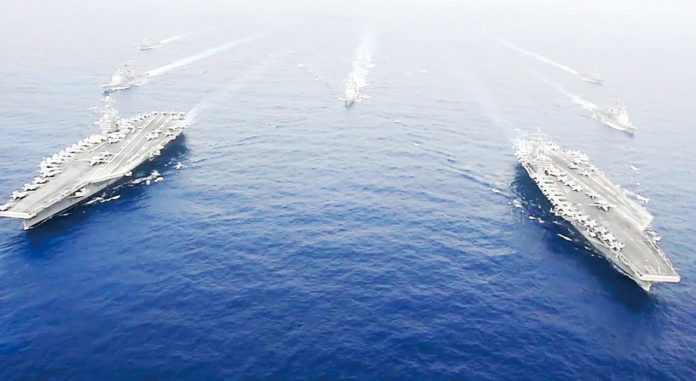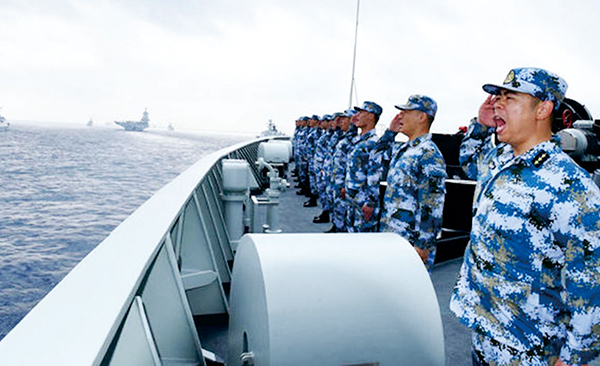

Washington’s Policies Increasingly Hawkish Towards China
The US State Department effectively rejected nearly all of China’s claims and activities in the South China Sea, through a statement on “US Position on Maritime Claims in South China Sea” by US Secretary of State Mike Pompeo on 14 July, which came soon after the US conducted its first dual aircraft carrier exercises in the South China Sea in six years.
Pompeo warned that the “world will not allow Beijing to treat the South China Sea as its maritime empire” and that America “stands with our Southeast Asian allies and partners in protecting their sovereign rights to offshore resources, consistent with their rights and obligations under international law.”
America’s unprecedented statement against China’s maritime moves marks a provocative new chapter in their South China Sea showdown.
In his statement, Pompeo invoked the 2016 award handed down by an arbitral tribunal at The Hague that ruled in favor of the Philippines over China under the United Nations Convention on the Law of the Sea (UNCLOS). The decision, which China has ignored, questioned the legal basis of Beijing’s expansive claims under its nine-dash line that lays claim to most of the sea. The arbitral award, handed down four years ago on July 12, “rejected (China’s) maritime claims as having no basis in international law.”
The Chinese Foreign Ministry statement countered that Washington has not yet ratified the UNCLOS.
US Defends SE Asian Allies’ Interests
In a shot across China’s bow, Pompeo specifically rejected China’s claim over land features such as the Scarborough Shoal, Second Thomas Shoal (defended by a Philippine marine detachment) and the Mischief Reef, all of which fall within “areas that the tribunal found to be in the Philippines’ exclusive economic zone (EEZ) or on its continental shelf.”
Aside from its mutual defense treaty ally in the Philippines, the US now also effectively supports the claims of other regional partners, including Vietnam, Malaysia and even Indonesia amid recent rising tensions with China off the energy-rich Natuna islands.
In its statement, the US said that it “rejects any [Chinese] maritime claim in the waters surrounding Vanguard Bank (off Vietnam), Luconia Shoals (off Malaysia), waters in Brunei’s EEZ, and Natuna Besar (off Indonesia).”
It also effectively reaffirmed Malaysia’s claim over the China-claimed James Shoal, since it’s “an entirely submerged feature only 50 nautical miles from Malaysia and some 1,000 nautical miles from China’s coast,” the US statement said.
China’s Response
China’s Foreign Ministry struck back by accusing the US of “deliberately distorting the facts and international law” It said the US “exaggerates the situation in the region” in order to “sow discord between China and other littoral countries.”
The Chinese statement maintained that the South China Sea situation “is peaceful and stable and is still improving” and decried the US for “flexing muscles, stirring up tension and inciting confrontation in the region.” It added: “China is firmly opposed to it.”
US Carrier Force Exercise
US aircraft carriers the USS Ronald Reagan and USS Nimitz with 120 fighters were both deployed for drills in the South China Sea when Pompeo made the foreign policy statement related to the SCS. The exercises took place near Paracel Islands off the Vietnam coast and north of Chinese nuclear submarine base at Hainan Islands. That exercise began on July 4 with “each strike group on its respective operational tasking.”
America’s deployment of the carriers was a “freedom of navigation operation” carried out for the fifth time this year.
The last time that three American aircraft-carriers prowled the Pacific Ocean was in 2017, shortly after President Donald Trump had threatened to “totally destroy” North Korea.
The carriers resumed rare dual exercises in the SCS, teaming up for the second time in July in contested waters. The two-carrier strike force trains to the highest levels of readiness to ensure responsiveness to any contingency through power projection.
The presence of the Nimitz and Reagan in the South China Sea marked the first time two US aircraft carriers have operated together there since 2014 and only the second time since 2001.
A day after Pompeo’s announcement, a US guided missile destroyer sailed near the Chinese-claimed Spratly Islands, also known as the Nansha Islands in China. The move was described as a “freedom of navigation” operation, part of the US Navy’s commitment to asserting “the rights, freedoms, and lawful uses of the sea recognized in international law by challenging the restrictions on innocent passage.”
The Navy used similar language when the two carriers joined up in the South China Sea again on 17 July.
China said the U.S. sent ships to the SCS to flex its muscles. Foreign ministry spokesman Zhao Lijian said, on 6 July, that the United States had deliberately sent its ships and accused Washington of trying to drive a wedge between the countries in the region.
Air Defence Identification Zone
For a decade, Chinese leaders have mulled the creation of an Air Defence Identification Zone (ADIZ) over the South China Sea. China established its first ADIZ in 2013 over the East China Sea. Controversially, it covered the uninhabited Senkaku islands. These are controlled by Japan but claimed by China (which calls them the Diaoyu). America promptly sent two bombers to fly through the zone without permission, to show it would pay no heed. Chinese leaders are now “waiting for the right time” to declare plans for an ADIZ in the South China Sea, according to the South China Morning Post. China may see an ADIZ in the South China Sea as a way of justifying more air patrols there.
An ADIZ there might be easier for China to monitor than the one in the East China Sea with the use of radars on Hainan island or the Chinese mainland coastline with gaps filled in using surveillance planes or fighter jets or radar-equipped destroyers.
Chinese foreign ministry spokesman Zhao Lijian arrogantly declared that “every country has the right to establish an ADIZ”, and said: “In the light of air security threats China faces over SCS waters, China will carefully and prudently study the relevant issues, taking into account all factors.”
India and the South China Sea
How the South China Sea situation plays out will be critical for India’s security. It is not China’s sea, Indians have sailed its water for centuries. Delhi has stakes in commerce, peace and security in Indo-Pacific.
Chinese military postures are cause for concern since unilaterally declaring the South China Sea as China’s territorial waters either carries the force of any treaty nor legal standing. The South China Sea is not China’s sea but a global common. India has historical rights established by practice and tradition to traverse the South China Sea without impediment.
Comments
The US is now also directly challenging China’s “historic rights” claims over energy and fishery resources across the South China Sea basin and beyond.
US’s proclamation that any action by China to harass other states’ fishing or hydrocarbon development in SCS waters or to carry out such activities unilaterally would be unlawful was music to the ears of China’s smaller neighbors. These statements represent a natural progression in Washington’s increasingly hawkish policies towards Beijing.
In recent years, the US has upgraded its security cooperation with new partners such as Vietnam, Malaysia and Indonesia, while maintaining its commitment to traditional allies like the Philippines.
Under the Pacific Deterrence Initiative, the US aims to increase its bases in Asia and make them harder for China to target in a missile attack, to show Beijing – and US allies – that America is ‘deeply committed’ to defending its interests in the region.
==================
China’s Aggressive Actions in the South China Sea
In the first half of 2020 alone, Chinese naval or militia forces have rammed a Vietnamese fishing boat, “buzzed” a Philippines naval vessel and harassed a Malaysian oil drilling operation, all within their respective EEZs. China conducted ballistic missile tests in the South China Sea in June 2019 and continues to enhance naval patrols to enforce area denial for others.
On April 3rd China’s coastguard sank a Vietnamese fishing boat near the Paracel islands.
On June 10th another one was rammed in the same area by a Chinese ship.
In April and May Chinese coastguard vessels harassed West Capella, a Malaysian drillship near Borneo, prompting America and Australia to send warships.
In the Spratly archipelago, China’s “maritime militia”, disguised as a fishing flotilla, has been swarming near Thitu, an island controlled by the Philippines but claimed by China.
Despite promising America in 2015 that it would not militarise the area, it has built ports, runways and bunkers in the Spratlys and installed missiles on these island fortresses.

















